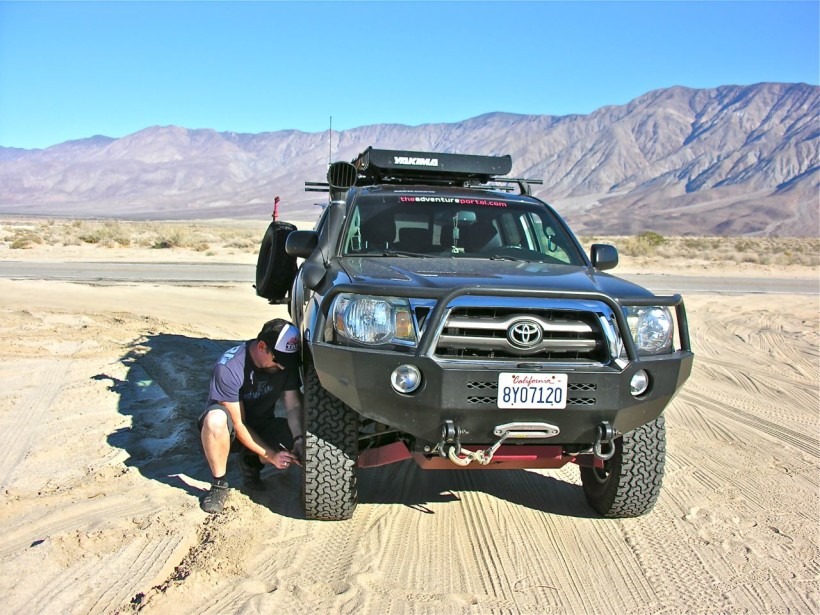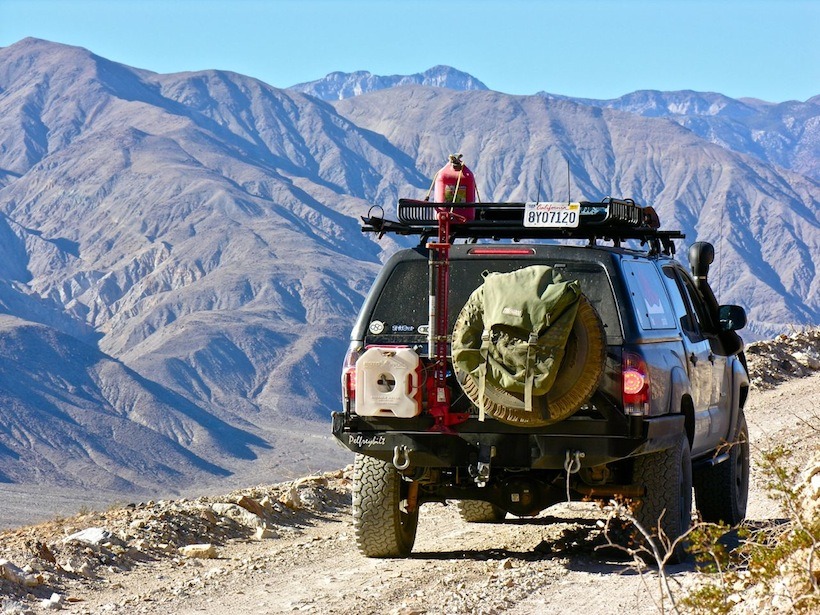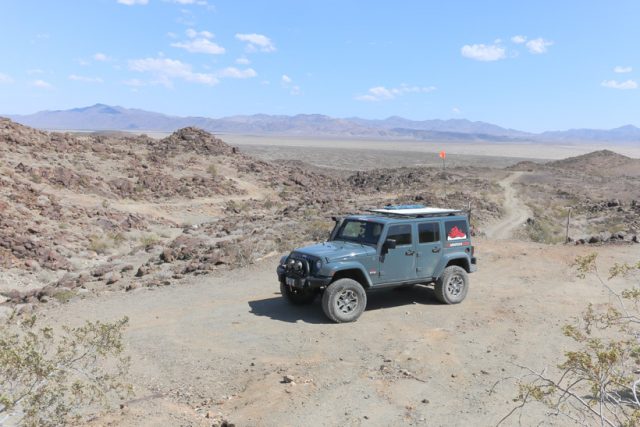This is the third in a 5 part series of safety articles written by Tom Severin of Badlands Off Road Adventures. Tom is an International 4WD Trainers Association certified professional 4WD trainer and a Wilderness First Responder (WFR). He is an instructor for the United Four Wheel Drive Association and the CA Association of 4WD Clubs.
Here’s what Tom has to say about his Top 10 “Must-haves” for safety:
“You’ve heard of David Letterman’s Top 10 list. I’ve also got one, but my list is serious. It’s designed to prepare you and your vehicle for safe off-road driving. While these are ranked in order of importance you should consider all recommendations to be critical to safe and successful four-wheeling.”
1. Enroll in a training course- Everybody should take at least one basic off – road course from an International 4WD Trainer’s Association certified instructor. The courses will cover a number of important topics including safe 4WD techniques, vehicle safety, trail etiquette, and environmental awareness. To find a certified trainer near you, visit the International 4-Wheel Drive Trainers’ Association.
2. Be knowledgable of complete overlanding safety- 4WD overlanding is, by nature, done in hostile environments. At a minimum you can get some bumps and bruises. Cuts and sprains are possible too; as are bug bites. A good first aid kit is comprised of at least four categories of products: tools, meds, wound care, and a fracture kit all stored in a water-proof container.
-Take a 72 hour Wilderness First Responder course. It will teach you how to deal with dislocations, severe cuts, anaphylatic shock and fractures. Go to Wilderness Medical Associates International.
-Make sure you have a good fire extinguisher in your vehicle. I suggest an ABC-rated 3lb rechargeable extinguisher with a gauge and a metal nose. A plastic nose will break off. Mount it where it’s quickly accessible, visible and securely mounted to avoid bouncing around your vehicle.
3. Make sure you have the ability to communicate- You will need to stay in touch while on the trails. CB radios are really popular. There are lots of brands and models to choose from, but I’ve heard good things about Cobra Brand Radios. You could also consider getting licensed as a ham radio operator. That would give you access to more radio frequencies, which extends your options.
-Make sure your equipment is securely mounted. Overlanding creates a lot of vibration inside the vehicle, which can disrupt equipment.
-If you decide on CB, buy the standard 1/4-wave antenna. Long whip-like antennas are not practical and can be dangerous off-road.
4. Have a recovery strap and tow-point- Tow points should be integrated into the vehicle frame. If it doesn’t already have towing hooks on the front and back. Go to a reputable shop and make sure the two points are rated for the GVW. The maximum operating weight/mass of a vehicle as specified by the manufacturer including the vehicle’s chassis, body, engine, engine fluids, fuel, accessories, driver, passengers and cargo but excluding that of any trailers. An optimal recovery strap should be 20,000 lb. rated (ultimate breaking strength) with loops sewn in the ends as opposed to metal hooks. Remember that this is a recovery strap, not a towing strap. They are two inches wide, and available in 20 and 30ft. lengths. Get one of each for options on distance or just use one length to start out.
5. Get all terrain or mud terrain tires- Replace the passenger tires with a good set of all terrain or mud terrain tires suited to your vehicle. Those provide better performance and hold up much better off road.
-Drive your vehicle for at least a year before making major modifications, such as adding traction control aides, bigger tires and other mechanical aides. This way you will have some time to develop your driving skills without mechanized help.
6. Invest in a good tire kit- Your kit should include:
-A good tire gauge (one that reads from 0-60 in 1lb. increments)
-a deflator
-a plug kit
Tires, as you can imagine, take a pounding on many trails, so you must be able to plug small cuts and holes. Also, get the Trailhead Automatic Tire Deflators. They can be set for your desired pressure and will stop automatically when they reach that pressure.

7. Purchase a Hi-Lift jack- These are extremely useful for off-road recovery and tire repair. A stock jack just won’t cut it. The only drawback is that the nose or lifting point is straight and flat, so it does not work with curved or round bumpers. There are adapters for vehicles with curved bumpers. Here is the link to a Hi-lift on Amazon. A good alternative to a Hi-Lift is an exhaust Jack. An example of this is the BUSHRANGER X-JACK from ARB.
8. Invest in a winch and winch kit- A winch is not absolutely necessary, but it provides peace of mind. I prefer that you spend your money on a winch rather than on lockers, lift etc., until you’ve honed your driving skills. Get a winch that is rated at least 1.5 times the GVW (Gross vehicle weight: maximum operating weight/mass of a vehicle as specified by the manufacturer including the vehicle’s chassis, body, engine, engine fluids, fuel, accessories, driver, passengers and cargo but excluding that of any trailers.) Mount is so that the bumper does not obscure a clear view of the full top of the winch. Your winch kit should include:
-a tree strap
-a pulley
-two D-rings (although 4 is better): the pin (clevis) in the D-ring measures 3/4″.
-a pair of leather gloves
Any brand of winch kit will do; all manufacturers sell quality kits.
9. Have an air compressor- There are many options. Some can be taken along in a bag and others can be installed permanently. Get one that taps directly into the vehicle battery. Those designed to be plugged into the cigarette lighter take too long to operate. Other alternatives are CO2 tanks and engine drive compressors. A really neat product is the “dual force”, a combined winch and compressor from Warn.
10. Don’t leave home without a vehicle repair tool kit- A basic kit is fine. Be sure to include the 4-wheeler’s ultimate tool, a BFH (Big Frickin’ Hammer).
10.5 TAP suggested Must Have: We spend a lot of time in the backcountry and because of this always carry a Personal Locator Beacon and Satellite Messenger device. There are several options/brands to choose from, but our personal choice is the Delorme In-Reach (with added flight extraction service). DO NOT expect your cell phone to have coverage!

TAP sends a big thanks to: Tom Severin, President
Badlands Off Road Adventures, Inc
4-Wheel Drive School
310-374-8047
https://www.4x4training.com
Do you have a “Must Have” for overlanding that is not mentioned here? Tell us in the comment section below.
















Since the topic is specific to overlanding, an absolute Must Have is a bare minimum of two days of food and water per person above and beyond the calculated length of your trip. Make it packable (MREs), because you may have to leave your vehicle behind. I keep almost a week’s worth under the rear seat of my Tacoma.
Another Must Have is at least one gallon of water reserved exclusively for the truck. I keep two 1-gallon Rotopax filled on my rack at all times, reserved for the truck (though if needed, they are potable).
Other Must Haves include a bottle of block sealer, a tube of JB Weld, a tube of ShoeGoo/Goop, duct tape and bailing wire………the list goes on.
All great points Shane. Thanks for sharing.
If you have some sort of communication device (which you should, I’m using HAM radio) or have left word of your travel plans with friends/family back in civilization, you do not leave your vehicle! Ask a pilot what is easier to spot from the air, a fully loaded rig or a person walking … (check any number of survival manuals, instructions, web-sites, …). You still need to carry the extra food/water/truck water/shelter building materials/… anyway.
Also, a must-have, 2 vehicles, I would say, highly recommended to travel with at least 2 vehicles, for recovery/rescue/evac if one breaks down. If you do insist on only 1 vehicle, a land anker might be a good idea.
As mentioned before, leave word with someone on your expected return date and ask them to alert SAR if you are late by 2 days.
Just a few thoughts…
All great suggestions Wouter. We almost always travel with two vehicles and on the rare occasions we’re in one, that’s when the Personal Beacon is most appropriate. Agreed always log your travel plans and times with someone you can rely on. Thanks!
Clarification, are you suggesting a 1.5 x GVW calculation for winch capacity or 1-5 (as in 1 to 5) times GVW?
We typically recommend 1.5-2 x GVW. Rigs are getting heavier and heavier…
I’d argue any winch will do but I am biased. 🙂
Nice piece!
Oops typo, yes 1.5x the GVW, but agreed everyone is adding more and more weight (including us!) so 2x definitely makes sense too. Thanks Jon! Andy